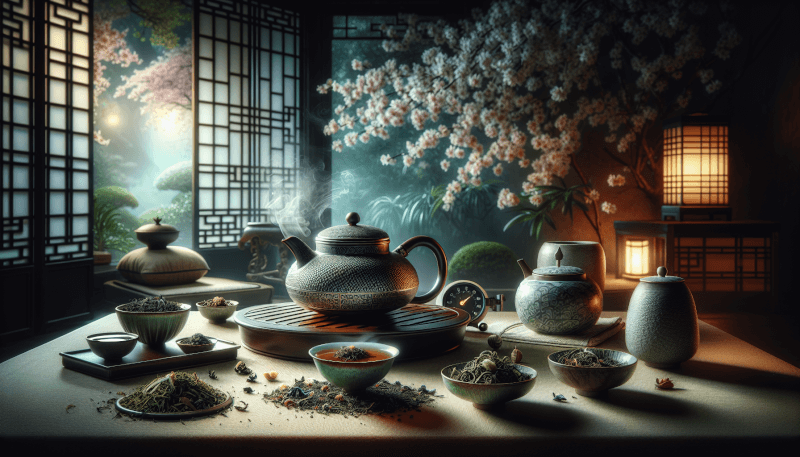Are you a tea enthusiast looking to enhance your brewing skills? Look no further! In this article, we will be sharing the top 10 most popular tea brewing tips that will take your tea-drinking experience to the next level. From selecting the perfect water temperature to properly steeping your tea leaves, these tips will ensure that every sip is bursting with flavor and aroma. So grab your favorite teapot and get ready to become a tea brewing pro!

Choosing the Right Tea
When it comes to enjoying a cup of tea, one of the most important factors is choosing the right type of tea. With so many varieties available, it can be overwhelming to know where to start. That’s why it’s helpful to know the different types of tea and their distinct characteristics. Whether you prefer a robust black tea, a delicate green tea, or a soothing herbal infusion, understanding the different types of tea will help you make an informed decision.
Know the Different Types of Tea
Tea comes in various types, such as black, green, oolong, white, and herbal. Black tea is fully oxidized and has a strong flavor, making it perfect for those who enjoy a bold cup of tea. Green tea, on the other hand, is lightly oxidized and has a more delicate taste. Oolong tea falls between black and green tea, offering a balance of flavors. White tea, known for its delicate and subtle taste, is the least processed tea variety. Herbal teas, also known as tisanes, are not made from the Camellia sinensis plant and can be enjoyed for their unique flavors and health benefits.
Consider Your Personal Preferences
When choosing the right tea, it’s essential to consider your personal preferences. Think about the flavors you enjoy and the effects you’re looking for. If you prefer a strong and robust taste, black tea might be your go-to choice. Those who appreciate a more delicate and grassy flavor might lean towards green or white tea. Herbal teas offer a wide variety of flavors, from floral to fruity and spicy. Consider experimenting with different types of tea to find your perfect cup.
Buy from Reputable Sources
To ensure that you’re getting the best quality tea, it’s important to buy from reputable sources. Look for tea vendors who specialize in high-quality loose-leaf teas and have a good reputation among tea enthusiasts. Avoid buying tea from questionable sources or pre-packaged tea bags, as the quality may be compromised. Reputable tea vendors often provide detailed information about the origin, processing, and flavor profiles of their teas, helping you make an informed purchase.
Using the Correct Water Temperature
The water temperature used for brewing tea plays a crucial role in extracting the right flavors and achieving the desired results. Different types of tea require different water temperatures to bring out their unique characteristics fully. Understanding tea temperature levels and knowing how to adjust them accordingly will elevate your tea brewing experience.
Understanding Tea Temperature Levels
Tea temperature levels can be grouped into three categories: boiling (100°C/212°F), near boiling (80-95°C/176-203°F), and below boiling (60-80°C/140-176°F). Boiling water is typically used for black, oolong, and herbal teas, as their robust flavors can withstand higher temperatures. Near boiling water is suitable for most green teas, while below boiling water is ideal for delicate white teas.
Boiling Water for Black, Oolong, and Herbal Teas
Black, oolong, and herbal teas are known for their bold flavors and can handle the high temperature of boiling water. Bring the water to a rolling boil, and then pour it directly over the tea leaves or tea bags. Let the tea steep for the recommended time to extract the full-bodied flavors.
Using Lower Temperatures for Green and White Teas
Green and white teas require lower water temperatures to prevent their delicate flavors from becoming bitter. Bringing the water to near boiling (80-95°C/176-203°F) and then allowing it to cool for a few minutes before steeping is the ideal method. This temperature range allows the delicate flavors of green and white teas to shine without being overpowered by heat.

Measuring the Right Amount of Tea
To achieve the perfect balance of flavors in your cup of tea, it’s important to measure the right amount of tea leaves. While it may be tempting to eyeball the measurements, following a recommended tea-to-water ratio ensures consistent results.
Following the Recommended Tea-to-Water Ratio
The general rule of thumb for brewing loose-leaf tea is to use one teaspoon of tea leaves per cup of water. However, some teas may require more or less depending on their specific characteristics. It’s always a good idea to refer to the brewing instructions provided by the tea vendor or experiment with different amounts until you find your preferred strength.
Using a Tea Scoop or Tablespoon
To measure the tea leaves accurately, you can use a tea scoop or a tablespoon. The advantage of using a tea scoop is that it is specifically designed to hold the perfect amount of tea leaves for a standard cup of tea. If a tea scoop is not available, a tablespoon can serve as a suitable alternative.
Adjusting the Amount Based on Taste Preferences
Everyone’s taste preferences vary, so don’t be afraid to adjust the amount of tea leaves to suit your personal taste. If you prefer a stronger cup of tea, you can increase the amount of tea leaves slightly. Conversely, if you prefer a milder taste, reduce the amount accordingly. Remember to take notes of your adjustments and find the perfect balance that pleases your palate.
Selecting the Ideal Brewing Time
The brewing time of tea is another crucial factor in achieving the desired flavor and strength. Different tea types require different steeping times to reach their optimal taste. By considering the tea type and your desired strength, you can ensure that your cup of tea is perfectly brewed to your liking.
Considering Tea Type and Desired Strength
Different types of tea require varying steeping times due to their unique characteristics. Black teas and herbal teas, for example, typically require a longer brewing time to extract their robust flavors. On the other hand, green teas and white teas have shorter steeping times to avoid bitterness and allow their delicate flavors to shine through. Consider the tea type and your desired strength when determining the ideal brewing time.
Shorter Steeping Times for Green and White Teas
To prevent green and white teas from becoming bitter, it’s important to keep the steeping time relatively short. Generally, steep green teas for 2-3 minutes and white teas for 3-4 minutes. However, these times can vary depending on personal taste preferences and the specific tea you’re brewing. It’s always a good idea to start with the recommended steeping time and adjust to your liking.
Longer Steeping Times for Black and Herbal Teas
Black teas and herbal teas can handle longer steeping times to fully develop their flavors. Steep black teas for 3-5 minutes, or longer if you prefer a stronger taste. Herbal teas, being caffeine-free, can steep for 5-7 minutes or more, depending on the desired intensity. Be mindful not to over steep, as it can result in a bitter taste.

Properly Preparing The Tea Leaves
Properly preparing the tea leaves before brewing can enhance your tea drinking experience. While some steps may be optional depending on the tea type, rinsing the tea leaves, loosening them with a tea needle, and breaking compressed tea cakes are common practices to ensure the best infusion.
Rinsing the Tea Leaves (Optional)
Rinsing the tea leaves before brewing is a traditional practice that some tea enthusiasts swear by. This step involves pouring hot water over the tea leaves, then immediately discarding the water. Rinsing the leaves can help wake them up, remove any impurities, and start the brewing process with a clean flavor. However, not all teas require rinsing, so it’s important to check the specific instructions for the tea you’re brewing.
Loosening Tea Leaves with a Tea Needle (Optional)
Certain teas, such as tightly rolled oolongs or compressed tea cakes, may benefit from loosening the tea leaves before steeping. To do this, gently insert a tea needle or a thin utensil into the tea leaves, being careful not to damage them. This step allows the water to penetrate the leaves more evenly and ensures a more even infusion. Again, this step is not necessary for all teas, so consult the brewing instructions for guidance.
Breaking Compressed Tea Cakes (If Applicable)
Compressed tea cakes, often found in aged Pu-erh teas, require breaking apart before brewing. Use a tea knife or another suitable tool to carefully separate the tea leaves from the cake. Breaking the compressed tea cake allows for better water circulation during steeping and ensures that the leaves are evenly distributed to achieve a consistent flavor.
Using Quality Water
Water is a crucial ingredient in brewing tea, and using the right quality of water can make a noticeable difference in the taste of your tea. Consider choosing filtered or spring water and avoid using distilled or tap water for the best results.
Choosing Filtered or Spring Water
When possible, using filtered or spring water is recommended for brewing tea. Filtered water helps remove impurities and minerals that could affect the taste of the tea. Spring water, on the other hand, tends to have a balanced mineral content and can enhance the flavors of the tea. The choice between filtered and spring water depends on personal preference and the quality of water available to you.
Avoiding Distilled or Tap Water
Distilled water, while purified, lacks the minerals that play a role in bringing out the nuances of tea. It can result in a flat tasting cup of tea. Tap water, depending on the quality, can also impact the flavor of the tea due to the presence of chlorine or other additives. If tap water is your only option, consider using a water filter pitcher or letting the water sit out for a while to allow some of the chlorine to dissipate.
Maintaining a Suitable Water pH Level
Tea brewing is most effective when the water pH level is neutral or slightly acidic. To ensure that your tea tastes its best, aim for a pH level between 6 and 7. You can use pH testing kits or consult local water reports to determine the pH level of your water source. Adjusting the pH level, if necessary, can further enhance the flavors and overall tea experience.

Mastering the Art of Steeping
Steeping is the process of extracting flavors from the tea leaves by soaking them in hot water. By following the steps below, you can master the art of steeping and ensure that each cup of tea is a delightful experience.
Covering the Tea while Steeping
Covering the tea while steeping can help retain the heat and prevent the flavors from dissipating. A tea cozy, a small plate, or a lid specifically designed for teapots are effective ways to cover the tea vessel. By keeping the heat trapped, you encourage proper extraction and infusion of flavors, resulting in a more robust and well-rounded cup of tea.
Using a Tea Infuser or Strainer
Using a tea infuser or strainer is essential when brewing loose-leaf tea. These tools prevent the tea leaves from floating freely in the water and make it easier to remove them from the vessel. Whether you choose a mesh ball infuser, a basket infuser, or a teapot with a built-in strainer, find a method that suits your preferences and ensures that the tea leaves stay contained during the steeping process.
Avoiding Over-Steeping
Over-steeping your tea can lead to bitter flavors that overpower the desired taste. Each type of tea has an optimal steeping time to achieve the perfect balance. Set a timer or use a tea kettle with a built-in timer to ensure that you don’t exceed the recommended time. If you prefer a stronger taste, it’s better to increase the amount of tea leaves rather than prolong the steeping time.
Experimenting with Tea Enhancements
While a simple cup of tea can be a delight on its own, experimenting with tea enhancements can add a new level of complexity and enjoyment to your tea experience. Whether it’s adding honey, lemon, or milk, trying different herbal infusions, or exploring unique flavor combinations, there are endless possibilities to discover.
Adding Honey, Lemon, or Milk
Adding honey, lemon, or milk to your tea can enhance the flavors and create delightful combinations. Honey adds a natural sweetness, lemon adds a tangy brightness, and milk provides a creamy richness. Experiment with different amounts and combinations to find the perfect balance that suits your taste preferences. Keep in mind that not all teas pair well with these additions, so trust your palate and enjoy the adventure of exploration.
Trying Different Herbal Infusions
Herbal infusions are a wonderful way to explore new flavors and tap into the countless health benefits of various herbs. From calming chamomile to refreshing peppermint and spicy ginger, herbal infusions can be enjoyed on their own or blended with your favorite tea. Don’t be afraid to try different combinations and create your own herbal tea blends to suit your mood and desired effects.
Exploring Unique Flavor Combinations
For those who enjoy experimenting with flavors, tea offers a wide range of possibilities. You can add dried fruit, spices, or herbs to your tea for a unique twist. For example, a pinch of cinnamon can enhance the sweetness of a black tea, while a sprig of fresh lavender can add a floral note to a green tea. Get creative and discover exciting flavor combinations that bring a new dimension to your tea experience.

Storing Tea Properly for Freshness
To maintain the freshness and flavor of your tea, proper storage is crucial. Exposure to light, moisture, and strong odors can compromise the quality of your tea. Follow these simple guidelines to ensure that each cup of tea you brew is as fresh and flavorful as possible.
Using Airtight Containers
Storing your tea in airtight containers is essential to protect it from exposure to air, which can lead to oxidation and flavor degradation. Choose containers made of ceramic, glass, or metal that have airtight seals. Avoid storing tea in transparent containers to prevent exposure to light, as it can affect the tea’s quality and flavor.
Avoiding Exposure to Light, Moisture, and Strong Odors
Light, moisture, and strong odors are the enemies of tea freshness. Store your tea containers in a cool, dark place away from direct sunlight to preserve their flavors. Moisture can cause tea leaves to lose their aroma and become stale, so it’s important to keep them dry. Additionally, tea leaves are highly absorbent, making them prone to picking up strong odors from their surroundings. To prevent this, store your tea away from strong-smelling substances such as spices or cleaning products.
Keeping Different Tea Types Separate
To prevent flavor cross-contamination, it’s best to store different types of teas separately. Each tea type has its own distinct flavors and aromas, which can be easily influenced by surrounding scents. Keeping black, green, oolong, white, and herbal teas in separate containers ensures that their unique characteristics are preserved.
Appreciating the Ritual of Tea Brewing
While the process of brewing tea can be seen as a routine task, taking the time to appreciate the ritual can enhance the overall tea-drinking experience. By creating a calm and relaxing environment, savoring the aroma, and enjoying the process, you can elevate your tea brewing to a mindful and enjoyable practice.
Creating a Calm and Relaxing Environment
Brewing tea can be an opportunity to create a peaceful and tranquil environment for yourself. Find a cozy spot, free from distractions, where you can focus on the present moment. Dim the lights, play calming music, or simply enjoy the silence while you prepare your tea. Taking a few moments to create a calm atmosphere can make a significant difference in your overall sense of relaxation and enjoyment.
Taking Time to Savor the Aroma
The aroma of tea is an essential part of the tea-drinking experience. As you brew your tea, take a moment to savor the delightful scents that fill the air. Close your eyes and inhale deeply, allowing the aroma to awaken your senses. Appreciating the fragrance of the tea can foreshadow the flavors to come and enhance your anticipation and enjoyment.
Enjoying the Process and Experience
Tea brewing is not just about the end result; it’s also about the process and the experience. Embrace the opportunity to slow down, be present, and engage your senses fully. Pay attention to the color of the tea as it infuses, the sound of boiling water, and the warmth of the cup in your hands. By fully immersing yourself in the experience, you can cultivate a deeper connection with your tea and derive greater pleasure from each sip.
By following these tips and adopting a mindful approach to tea brewing, you can enhance the quality and enjoyment of each cup of tea you brew. From choosing the right tea to appreciating the aromas and flavors, the art of tea brewing is an enriching experience that can bring moments of tranquility and pleasure to your daily routine. So grab your favorite tea leaves, heat up some water, and embark on a journey of tea discovery. Cheers to the perfect cup of tea!


